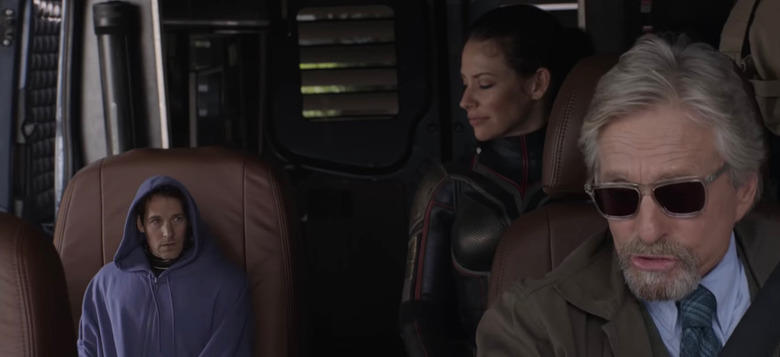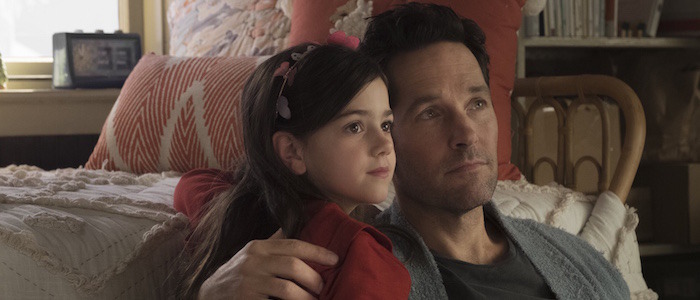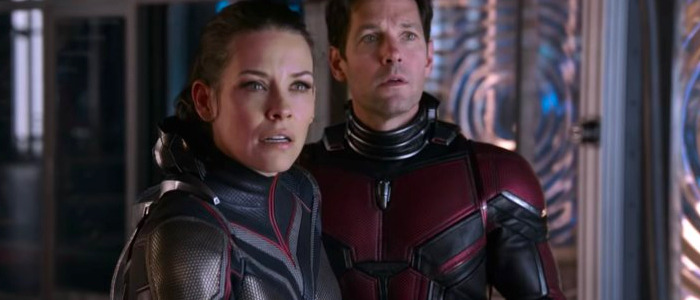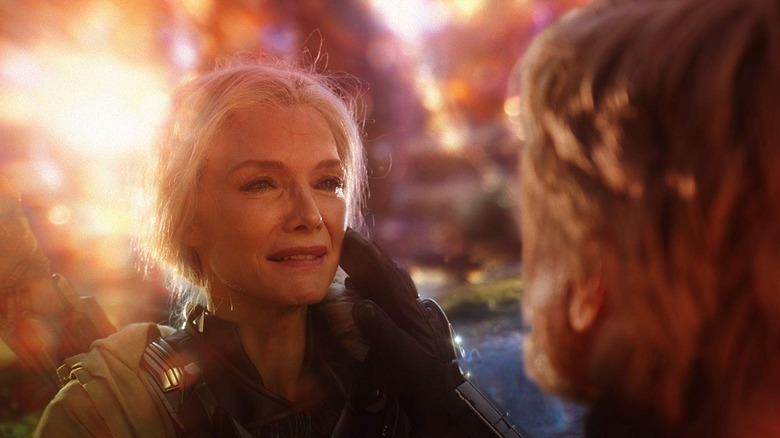Road To Endgame: 'Ant-Man And The Wasp' Breaks From The Marvel Formula, But Does It Matter To The Larger MCU?
(Welcome to Road to Endgame, where we revisit the first 22 movies of the Marvel Cinematic Universe and ask, "How did we get here?" In this edition: Ant-Man and the Wasp is an easy, breezy, meaningless entry.)As the Marvel Cinematic Universe increases in bombast, it needs the occasional palette-cleanser. The bloated Avengers: Age of Ultron was followed by Ant-Man, a heist film in the vein of a studio comedy. Similarly, the gargantuan Avengers: Infinity War was succeeded by Ant-Man and the Wasp. The Ant-Man films are as literal as "going smaller" gets, focusing not only on shrinking superheroes, but on intimate father-daughter dynamics, thus steering the MCU away from its usually apocalyptic stakes.As with its predecessor, though, Ant-Man and the Wasp begs the question: is smaller inherently better when it comes to superheroes?For what feels like the first time since Thor: The Dark World, a Marvel movie fails to be about anything in particular. Ant-Man and the Wasp is hardly a contender for bottom spot — it's too well-meaning, and its supporting cast is too likable for the film to be truly worthless — and it breaks from Marvel's traditions in notable ways. A handful of these deviations are refreshing. For instance, tonal consistency, along with visual and aural filmmaking that actually matches it. Other departures however, render the film thematically vapid, making it stick out even further in a series so otherwise loaded.
Marvel and Meaning
Marvel Studios rarely goes all-on on dramatizing its themes; the series' priority is entertainment above all else, including meaning. But while its latent ideas rarely come to the fore, they form a framework within which its narratives operate.The Iron Man films, confused though they may be, center on the idea of a reformed weapons manufacturer wrestling with political power. And while entries like Iron Man and Iron Man 2 are colossally paradoxical — both films were funded and approved by the U.S. military, as were Captain America: The Winter Soldier and Captain Marvel — the backdrop of politics and military conflict makes for fertile narrative ground, propaganda or otherwise. Even Guardians of the Galaxy and Guardians of the Galaxy Vol. 2, space-operas bookended by showy theatrics, are grounded in themes of abuse and emotional barriers.The Marvel films all follow a particular roadmap when it comes to dramatic expression. Fictitious entities or antagonists stand-in for real ones so as not to ruffle political feathers, while heroes, more often than not, come to some realization about their responsibility or trauma that ultimately makes them punch harder. Twenty movies in, this structure is admittedly frustrating, but it provides a sense of momentum.Even a film like Avengers: Infinity War — so engorged by disconnected ideas that it required not one, but two of these deep-dives — ends up striking a chord, because its characters adhere to familiar dramatic textures. They want. They need. They're held back by their own egos, even if a lack of lasting consequences prevents their stories from amounting to very much. That Ant-Man and the Wasp doesn't feel like any Marvel movie ought to be a blessing. However, the film never attempts to replace the Marvel formula with a workable alternative.The heroes and apparent villains share the same objectives, so the film features no real external antagonist. This reprieve centers likable characters without the need for bitterness, but there's little internal conflict either. The story forgoes pretense in the realm of political statement, but its personal dynamics have little to say. It refuses to fall back on the usually exhausting Marvel climax, but instead of big battles and far-too-smooth mayhem, it offers almost no climax at all.Ant-Man and the Wasp proves, at once, how little underlies the Marvel formula when its specifics are stripped away, and yet how effective that formula is for popcorn entertainment.
Fathers and Daughters
First things first: Abby Ryder Fortson ought to be a regular fixture of the Marvel Universe. As Cassie, daughter of Ant-Man/Scott Lang (Paul Rudd), she injects the Ant-Man series with a sense of genuine warmth, something she's been doing effortlessly since the age of six. Cassie is an all-time great movie kid, and Fortson's screen-presence opposite Rudd gives Ant-Man and the Wasp its glimmer of childlike mischief.Cassie, a future Avenger herself (the comics' Stature) is barely fazed by giant ants. In fact, she greets them with a smile. Her scenes are never twee, in that mechanical way that makes you wonder if the filmmakers have ever met an actual child. And while she's never the center of the sequel's conflict, her doe-eyed, jokey dynamic with her father inspires the best in him.This helps the film outdo its predecessor in one vital way. Characters like Hank Pym (Michael Douglas) no longer need to stop the film in its tracks to extemporize Lang's story. This time, Lang attempting to be worthy of his daughter is an implicit backdrop, rather than a repetitive promise of an arc that never fully manifests.Like the first film, the father-daughter dynamics here are central to the story. It opens in flashback, with Pym re-explaining the disappearance of his wife Janet Van Dyne (Michelle Pfeiffer), the original Wasp, to his daughter Hope (Evangeline Lilly). Though the prologue doesn't hint at Pym's subsequent aloofness during Hope's childhood. This earlier conflict between the two characters disappears entirely, despite never really being resolved in Ant-Man.The purpose of this opening, however, is to establish that Janet might still be alive in the Quantum Realm, and that the heroes will spend the remainder of the film trying to get her out. The scene is functional, and it hints at the film's heist-like nature, thus injecting a deeply personal element into familiar genres. But this foundational sequence never sets up anything resembling emotional friction for Hope, Pym or Lang.The father-daughter scientist duo is now on the run, thanks to Lang's actions in Captain America: Civil War. They hold a slight grudge against Lang for this. However, they never have to work through their conceptions of him in order to enlist his help — his memories of the Quantum Realm are vital to saving Janet — nor does Lang take any concrete steps to earn back their trust. The film's third father-daughter duo features the closest thing to dramatic tension. Bill Foster (Laurence Fisburne), Pym's spurned former college, looks after Ava Starr a.k.a. Ghost (Hannah John-Kamen). The accident that killed Ava's parents also suspended her in a state of painful quantum phasing; her cells continually dislodge and re-align, and she appears to constantly travel a few seconds backward and forward in time.Ava wants to extract Janet from the Quantum Realm too, though she hopes to use the energy Janet has absorbed in order to save herself from agony. According to the other characters, this procedure will likely kill Janet. Foster intends to assist Ava but their methods often clash, with Foster colouring within moral lines while Ava grows desperate enough to consider kidnapping Lang's daughter. Though after a brief, stern exchange between Ava and Foster, neither this idea, nor anything like it, crops up a second time.Ava partially shares her objective with the heroes. That they both wish to retrieve Janet from the Quantum Realm is potentially momentous — several action scenes feature Ava and Hope fighting over tech — but given the way the film is structured, (both its plot, and its emotional mechanics) this similarity has little to no bearing on how the story plays out.There even comes a point, less than half way through the film, where nearly everything is resolved.
Structure
Ant-Man and the Wasp feels more whole than its predecessor. Last time around, director Peyton Reed came on board after Edgar Wright's departure (Ant-Man therefore felt like a product of conflicting re-writes) but here, Reed and the writing team, which included Paul Rudd, weren't working from someone else's blueprints. The result is a Scott Lang who feels like a complete person — everything from his bathroom routine to how he functions in a world of scientists — rather than a product of how other characters see him.Lang's scenes with Cassie, with his parole officer Jimmy Woo (Randall Park) and with the returning security team of Luis (Michael Peña), Dave (Tip Harris) and Kurt (David Dastmalchian) are given room to breathe. They're shot and edited with singular goal of comedy, mostly through reaction shots. These scenes rarely feel forced, given how the jokes emanate from character — Kurt's Baba Yaga story is a particular delight, as is Uzman's (Divian Ladwa) dislike of the phrase "truth serum" — though this easy, breezy tone extends to the more serious parts of the narrative.Hope finally has more to do this time, and Evangeline Lilly is allowed to wear the character's recent history on her sleeve. Literally; after years in hiding, her loose-fitting, low profile outfit is a significant change from her business suits, and Lilly carries herself with the requisite vigilance and exhaustion. However, while Hope and Pym display the occasional annoyance (largely at Lang, though to no real end), most of their missions to retrieve and assemble their Quantum Tunnel go relatively unimpeded.After the first big action scene, which pits Hope against both Ava and perfunctory-yet-delightful business criminal Sonny Burch (Walton Goggins), the heroes' path to assembling their machine features few physical or emotional challenges. There's little risk of being recognized when they seek out Bill Foster for advice, despite them joking about their poor disguises, and there's not a child in sight when Lang and Hope steal the Ant-Man suit from Cassie's schoolbag.Once the heroes are captured by Ava (and once Foster reveals himself to be on her side, in only his second scene), Pym is barely challenged by these two products of his mistakes: one scorned former coworker, and the daughter of another. Ava constantly moving backward and forward in time doesn't seem to warrant a mention, even though it makes for a perfect mirror to Pym, a man defined by the regrets of his past.The team swiftly escapes Ava's captivity thanks to their ant friends. And, as if to inadvertently highlight the unimportance of their journey, the film cuts right from the middle of the action here, to Pym assembling his device. At the fifty-minute mark — with a full hour remaining — Pym, Hope and Lang have everything they need to build the Quantum Tunnel. They're working in tandem, they possess the mechanism to retrieve Janet, and there's nowhere else for them to go as characters.From this point on, conflicts arise thanks to characters un-connected to the Janet plot. Burch, Uzman, Luis, Dave and Kurt are certainly entertaining — Luis' narrated montage is the good kind of fan-service — but their effect on the ticking clock to retrieve Janet is entirely incidental. Which isn't inherently an issue, of course; throwing every possible problem at the heroes ought to make for an engaging story. The real problem is that while Pym, Hope and Lang are entirely fleshed out this time, they're also entirely stagnant.Traditional narrative arcs aren't necessary for every superhero (See also: Captain America) but in the process of robbing these particular characters of growth and change, the narrative itself is robbed of meaning. These three have every reason to be in conflict with one another — Pym betrayed Hope, Lang betrayed them both — and Pym has just as many reasons to be at war with himself, since both Janet's disappearance and Ava's accident were products of his technology.And yet, while every main character wants to retrieve Janet, the potential ripple effects of this interconnected objective never play out, despite being explicitly mentioned.
The Janet Problem
The film's lacking momentum stems from one place: Janet Van Dyne. Not the character herself, mind you — Pfeiffer is a neat addition to the Marvel Universe, despite the brevity of her role — but rather, how Janet's story is framed.That's she's mostly a MacGuffin is questionable. We can argue in circles about the optics of reducing the comics' original female Avenger to a mere plot device (or erasing her from the first film entirely), but how she functions even within this context is where the film begins to falter. The story kicks off with Janet's disappearance (an admittedly kinetic sequence) and ends with her being rescued. The film is about Hank Pym and Janet Van Dyne; they're just as much the "Ant-Man" and the "Wasp" of the title as Lang and Hope. And yet, in the process of being about Janet, the film is about nothing at all.Pym's guilt over losing Janet, and Hope's subsequent resentment of Pym, were each character's defining trait in Ant-Man. Yet in the sequel, the magnitude of having Janet back — the very person around whom these characters revolve, not only despite her absence, but because of it — is null and void. Pym and Hope's estrangement was never full resolved, and by them never coming into conflict over Janet's disappearance, their plan becomes all too easy. All that stopps them from jumping into the Quantum Realm at the fifty-minute mark are the scientific specifics, and unrelated characters several miles away.Lang, too, seems unaffected by Janet, despite her having planted messages inside his head. They have shared their very consciousness — Janet even speaks through Lang's body in order to reach her husband and daughter — yet none of this has any bearing on Lang, whose defining relationships are to Hope, and to his own daughter. Nothing, not even seeing Hope through her mother's eyes, changes his perception of either Hope or Cassie in a way that helps his relationships evolve.What little conflict the film does have is undone by the Janet problem as well. Foster, at one point, tries to convince Ava not to kill Janet in order to save herself; what separates Ava from the heroes is her desperation and her lethal methodology. Though once Pym gets Janet home, this moral dilemma — trading lives, which Marvel has previously mined to significant effect — disappears entirely. Janet simply uses powers she gained in the Quantum realm to solve Ava's problem.What little the film is about, it eventually ceases to be about it.None of this is en route to setting up future installments either (it would hardly rescue the film if it were, but it'd be something). The major developments in the overall story occur after the credits. We haven't yet discussed post-credit scenes on the Road to Endgame, since they aren't really part of the films. But for the first time, one of these teasers feels major enough to be narratively vital.In order to set up Avengers: Endgame, three of the four main characters die — a bizarre tonal shift in an otherwise comedic entry — leaving one of them sub-atomically stranded. It's entirely disconnected from the rest of the film, and yet, it's also the only thing approaching an actual consequence, or a shift from the status quo. It's the promise of change and challenge in the future, but a promise that may or may not be fulfilled; perhaps Ant-Man and the Wasp is a Marvel movie after all.




